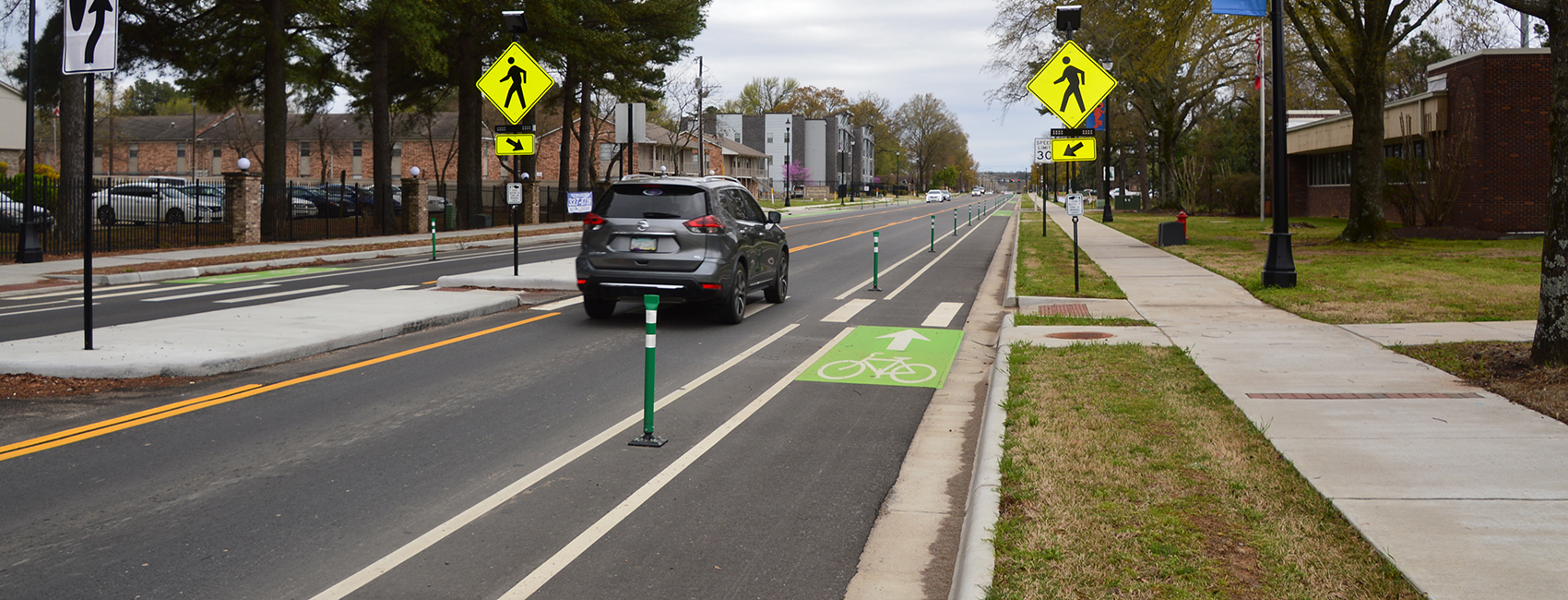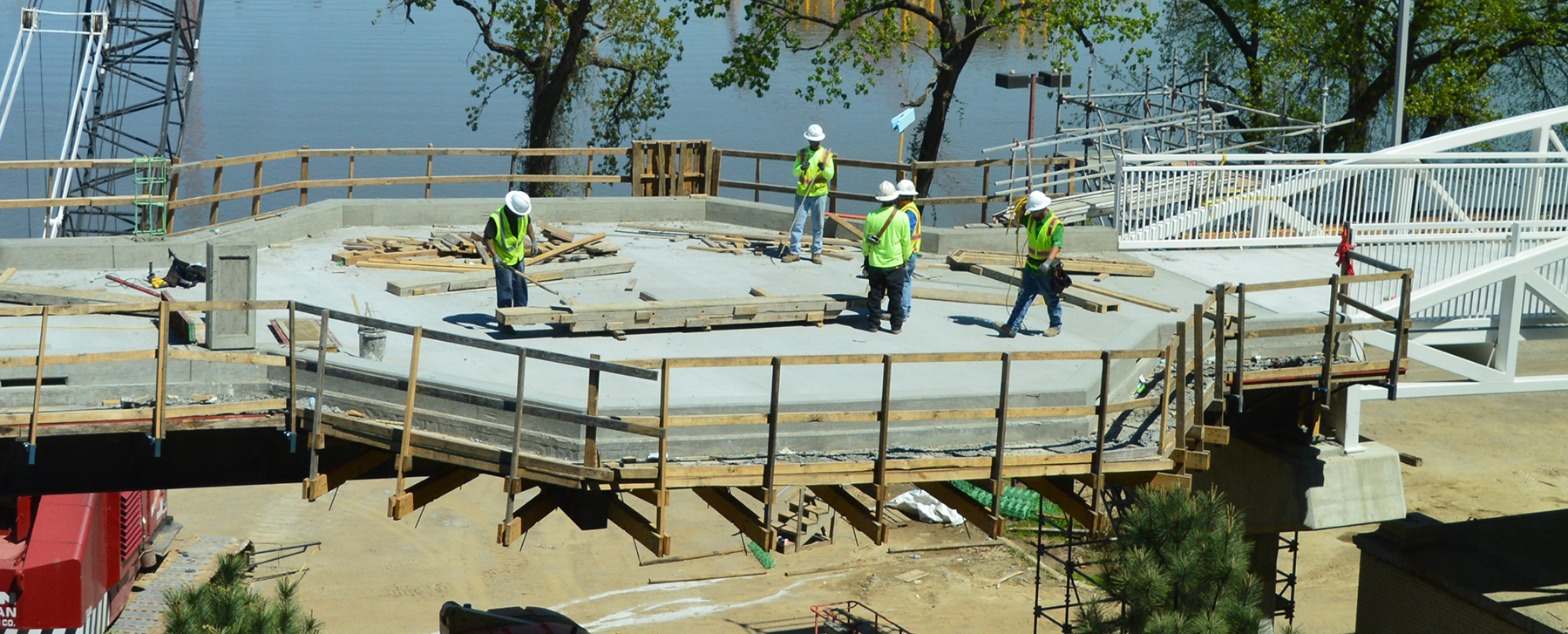TRANSFORMING MOBILITY
Chapter 3 of Transforming Mobility provides a policy framework and identifies planning study needs for the future of Central Arkansas’ transportation system and complementary land development. This chapter relies on federal regulations, public input, and cooperation with our regional partners and their planning efforts to inform our region’s goals and guiding policies.
Metroplan is empowered by 10 Federal Planning Factors, found in regulations 23 CFR 450.306(b), but driven by the desire to see the region reach its potential as an accessible, equitable, and sustainable home for its 700,000 residents. With the frame of previous plans, we engaged our Advisory Committees to develop five “Regional Goals” for a Central Arkansas transformed through greater mobility for multiple modes.
Metroplan continued this work as it standardized best practice policies for both land development and transportation through several documents. Chapter 3 introduces previous MTPs, the Unified Development Code, Multimodal Guidelines, Regional Greenways Plan, Safety Action Plan, and other influencing plans and recognizes where more guidance is needed in future Metroplan studies. Core Policies are supported by these documents that serve as a foundation for implementation and achieving our Regional Goals.
Metroplan is empowered by 10 Federal Planning Factors, found in regulations 23 CFR 450.306(b), but driven by the desire to see the region reach its potential as an accessible, equitable, and sustainable home for its 700,000 residents. With the frame of previous plans, we engaged our Advisory Committees to develop five “Regional Goals” for a Central Arkansas transformed through greater mobility for multiple modes.
Metroplan continued this work as it standardized best practice policies for both land development and transportation through several documents. Chapter 3 introduces previous MTPs, the Unified Development Code, Multimodal Guidelines, Regional Greenways Plan, Safety Action Plan, and other influencing plans and recognizes where more guidance is needed in future Metroplan studies. Core Policies are supported by these documents that serve as a foundation for implementation and achieving our Regional Goals.
Plan Influences
Metro2020
Metro2020 started Central Arkansas’ journey towards a better transportation system. Metroplan’s foundational MTP has filtered down through the last three decades of planning. The plan first established a regional approach to investing in transportation while considering land development impacts on the system. This idea carries on currently.
Imagine Central Arkansas
Imagine Central Arkansas, 2013, broadened Metroplan’s planning focus beyond transportation and land use, adding more livability elements like housing, health, and the economy. Maintaining existing transportation infrastructure has become crucial policy today, as investment becomes more prudent with an aging, expensive system.
The Central Arkansas Green Agenda
Adopted in 2011, the Green Agenda’s four focuses: movement, power, nature and knowledge, resulted in 13 strategies and 106 actions to guide sustainable practices in transportation and development that would preserve air and water quality. These ideas have since woven into Metroplan’s MTPs and continue their influence in this plan.

Plan Influences, From Our Partners
In addition to Metroplan’s documents, Transforming Mobility is informed and advised by plans from transportation partners.
![]()
Arkansas Strategic Highway Safety Plan (ARDOT, 2022)—A comprehensive framework to reduce fatalities and serious Injuries on public roads.
Arkansas State Freight Plan (ARDOT, 2017)—Identifies trends, issues, and needs; outlines policies, strategies and performance measures; and identifies high priority projects to guide investments in freight.
Arkansas Electric Vehicle Infrastructure Deployment Plan (ARDOT, 2022)— Guides investments for new strategically placed Electric Vehicle Supply Equipment charging stations to increase access for travelers nationwide.
R.I.D.E 2020 (Rock Region METRO, 2020)—A comprehensive budget-neutral operational analysis to improve transit service in Central Arkansas that updates service area, improves directness and frequency, and expands microtransit while readjusting funding to meet current needs.
We Move Arkansas—Transportation 2040 (ARDOT, 2017)—Arkansas’s Long Range Intermodal Transportation Plan is a policy context that addresses transportation issues in Arkansas for the next 25 years. The long-range plan takes a big picture look at the goals of the transportation system over a long term horizon.
Arkansas Bicycle and Pedestrian Transportation Plan (ARDOT 2017)—This plan recognized the need and benefits of embracing walking and biking. These are integral to transportation and recreation and can strengthen economic and social vitality in the state’s communities. The plan identifies three goals and eight objectives to guide state initiatives.
Full Steam Ahead (ARDOT 2023)—ARDOT’s 2023-2028 Strategic plan to deliver a modern transportation system to enhance safety and quality of life. To reach this vision, it establishes ARDOT’s core values, goals and objective for the transportation system, its employees, customer service and partnerships.
Policy Formers
The Public Participation Plan (3-P)
The 3-P is a federally mandated document intended to (1) provide a guide to the planning process adopted by Metroplan; (2) increase public awareness and engagement; and (3) broaden the range of voices and views in the planning process. Critical to public engagement are transparency of process and ensuring early and continuing involvement in regional planning and implementation.
Unified Development Code
The Unified Development Ordinance (UDO), 2022, is a model zoning and subdivision regulation written for small cities but also applicable in neighborhoods of larger cities. It includes regulations for zoning, subdivision, utilities, and urban design. Led by its guiding principles – clarity, ease of use, flexibility, safety, connectivity, sustainability/resilience, and equity/choice – the UDO serves as a local implementation tool for many of this MTP’s core policies. (Appendix 2)
Multimodal Infrastructure Guidelines
These guidelines recognize that our streets should be shaped by the context of their location and accessibility for multiple types of users. Streets not only connect us to homes, jobs, education, services, and recreation, but they are also our most active and visible public spaces. They have a tangible impact on our residents’ quality of life, economic competitiveness, local business’s success, and visitors’ perceptions of the region. The guide establishes an approach to street design that prioritizes all modes and offers the opportunity to implement design decisions with consistency, providing predictability in costs and regional uniformity in function and style. (Appendix 3)
Regional Arterial Network Planning Study
The RAN was created in 2002 to provide a highly connected system of roads that provided a regional alternative to the freeway system. The plan Identified 29 corridors and deemed 16 of them priority for Investment. This document has
guided Metroplan’s Transportation Improvement Program development since the turn of the century. Projects such as intersection improvements, access management, technology upgrades, bridge replacement, and roadway widening were recommended for the subsequent 20-year period from adoption, and projects on these critical corridors continue today.
Central Arkansas Regional Greenways Plan
The study details six regionally significant active transportation corridors connecting the Little Rock-North Little Rock core to West Little Rock, northwest to Conway, northeast to Ward, east to Lonoke, southeast to Wrightsville and southwest through Saline County. The Metroplan Board set a strategic target of $55 million, over a ten-year period, in investments towards the construction of the 222-mile system of separated pathways to increase mobility for non-motorized travelers. The plan also recognizes critical trail segments and imparts design and wayfinding guidance for system buildout. (Appendix 4)
Central Arkansas Safety Action Plan
The plan will set goals, recommend policies, and identify demonstration projects to significantly reduce roadway fatalities and serious injuries to increase safety for all road users in Central Arkansas. The study will analyze current conditions system wide and consider equitable solutions for pedestrians, bicyclists, transit riders, motorists, personal conveyance and micro-mobility users, and commercial vehicle operators. (Appendix 6)
Corridor Specific Plans
Metroplan, ARDOT, and local sponsors often develop corridor plans that define needs and opportunities to improve our transportation network. These studies may examine new major connections, reassess capacity and traffic signal operations, or determine multimodal infrastructure needs along certain segments. Recent examples like the South Loop Study, East-West Connector, Highway 89, Highway 107 will inform project development in the MTP.

Regional Goals
Metroplan’s original 20-year MTP planning horizon sunset in 2020. Work towards the region’s new transportation vision began in 2019, as Metroplan formed the citizen-based Regional Advisory Committees and engaged the public through the Connecting Central Arkansas Public Outreach Initiative. After synthesizing the public’s contribution, the RAC recognized five recurring themes for the region’s future.
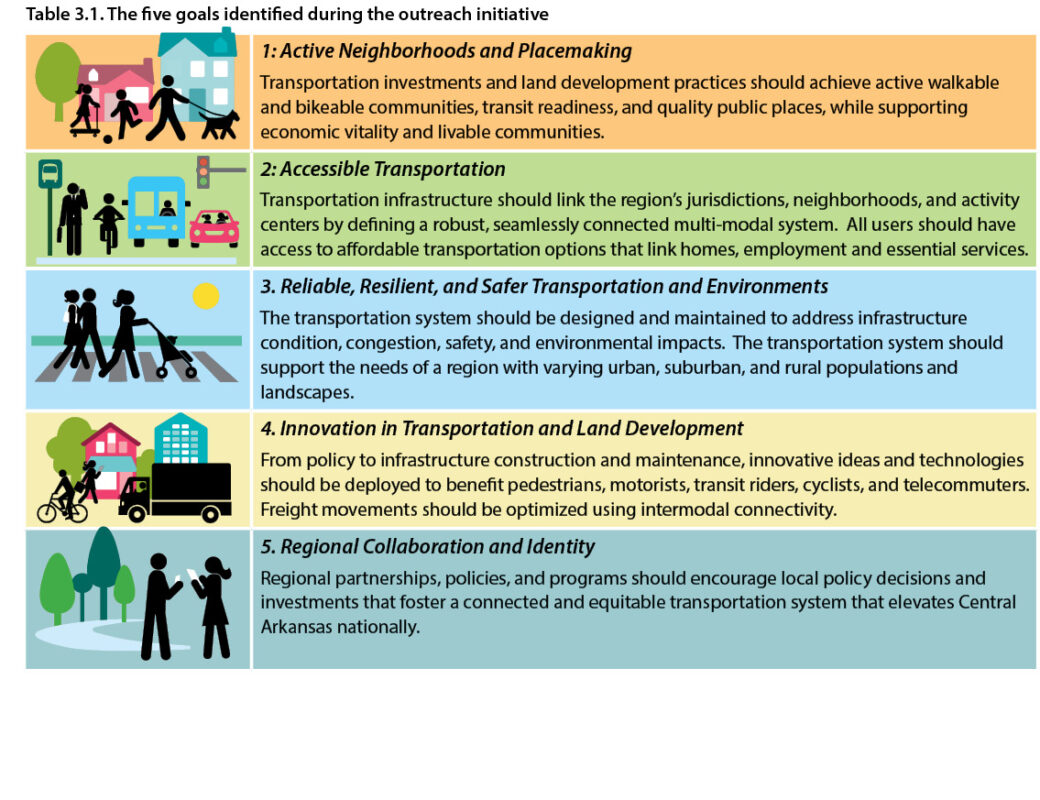
Implementation Roadmap
Through a synthesis of public outreach, review of existing plans from Metroplan and partners,
and the development of new planning documents, Central Arkansas: Transforming Mobility identifies nine core policies to guide Metroplan’s transportation decision
making and land development in the region. These policies move us closer to our regional goals.
Policy Discussion
Metroplan’s Core Policies reflect our commitment to strengthening communities and transforming mobility for all users in the region. These are strategies that help guide investments, reevaluate land development decisions, identify innovation, and collaboratively plan to align with our Regional Goals.
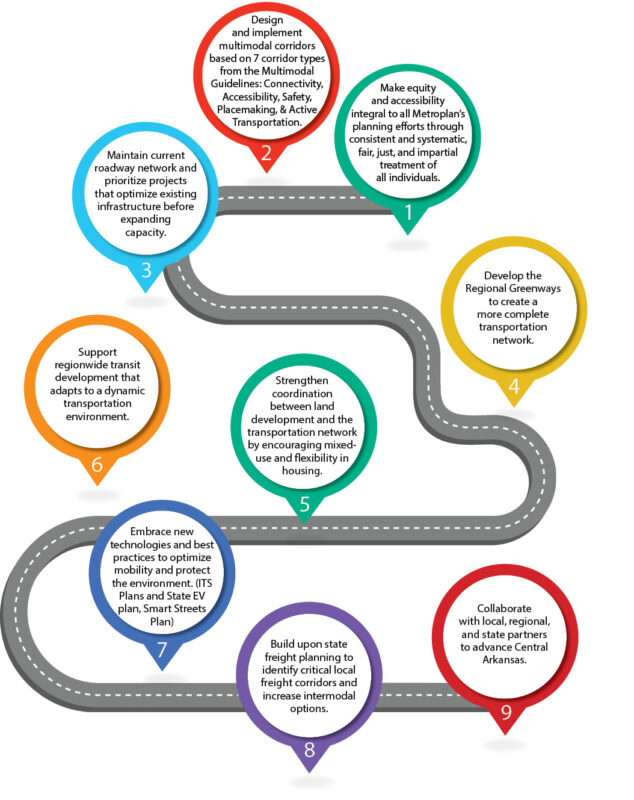
- Core Policy 1: Make equity and accessibility integral to all of Metroplan’s planning efforts.
- Core Policy 2: Design and implement multimodal corridors based on seven corridor types
- Core Policy 3: Maintain current roadway network before expanding capacity.
- Core Policy 4: Develop the Regional Greenways to create a more complete transportation network.
- Core Policy 5: Strengthen coordination between land development and the transportation network.
- Core Policy 6: Support regionwide transit development that adapts to a dynamic transportation environment.
- Core Policy 7: Embrace new technologies and best practices to optimize mobility and protect the environment.
- Core Policy 8: Build upon state freight planning to identify critical local freight corridors and increase intermodal options.
- Core Policy 9: Collaborate with local, regional, and state partners to advance Central Arkansas.
For Further Study
As Metroplan updates our plans, multimodality will take precedent. The connection between modes, intermodality, will also be recognized more thoroughly in future efforts. Balancing our transportation system for all modes means addressing gaps in our planning study guidelines. This discussion focuses on studies that Metroplan will update or pursue in the near future.
Congestion Management Process (Federal Requirement, To be Completed 2024)
A Congestion Management Process (CMP) is required for transportation management areas that address congestion management through a process for safe and effective integrated management and operations of the multimodal system (23 CFR § 450.322). Metroplan’s CMP will consider frequently congested locations, safety concerns, scheduled projects, CARTS Travel Demand Model results, and technology to provide a more reliable transportation network.
Regional Arterial Network Update
The RAN was last updated in 2003 and will be reevaluated to determine its utility. Financial realities and priorities have changed after 20 years of development. Arterial roads will continue to be important to regional mobility. However, projects today must reinforce our commitment to multimodal mobility and ensure that our investments provide the most benefits to our users. Projects that optimize our current infrastructure, or upgrades for other modes of transportation may mitigate the need for new capacity on our critical arterials. Metroplan will reassess its RAN during this planning horizon.
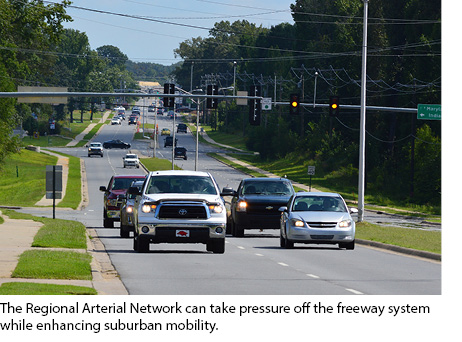
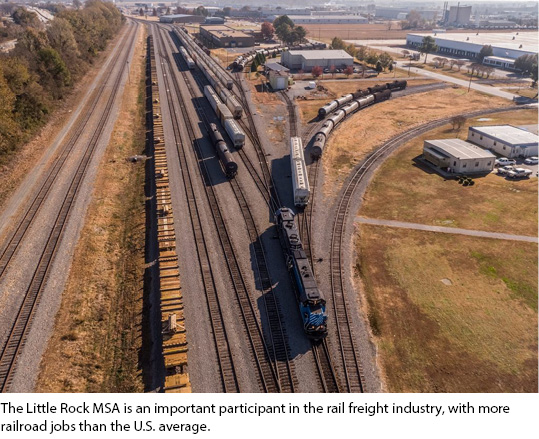
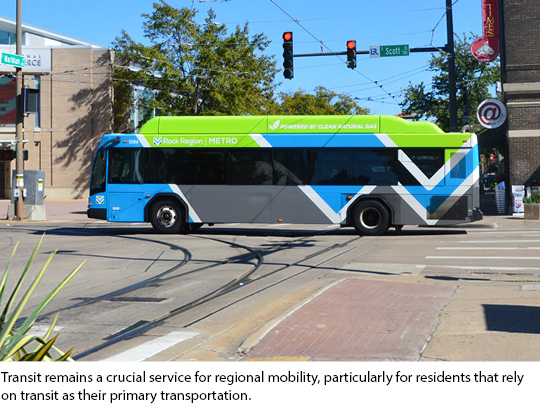
Regional Freight Plan
Metro2020 set the stage for freight planning in Central Arkansas, and that vision has carried throughout successive plans. Despite the sentiment, regional freight planning has been limited. Freight continues its importance as more goods are purchased online and retailers ship from burgeoning warehouse operations. The region is uniquely positioned on nationally significant freight corridors including I-40, the Union Pacific Railroad, and the navigable Arkansas River. This convergence should be leveraged, and a freight plan can optimize our economic opportunities.
Changing Freight Patterns
Freight movement has changed since 1998, when METRO 2020 was adopted. Then, freight was dominated by trucks on long national and regional routes stopping delivering to local stores and manufacturers and moving on to the next region. Now, more locally generated freight trips are occurring because online shopping and delivery are becoming a popular way to obtain goods and services. Grocery stores, take-out delivery, and retail distribution centers have flooded Central Arkansas. The region boasts several new and announced distribution centers as a result, including Lowe’s, Dollar General, and three from Amazon.
The Port of Little Rock, along the Arkansas River, is a major contributor to the regional economy, employing over 8,000 people. As a major generator of and destination for freight, its influence, and the need for planning, is expected to increase as more developable sites are added when the FAA’s navigational VOR cone is moved.
Regional Transit Plan
Transit has served the core of Central Arkansas for decades and is now finding its footing in Conway. In recent years, it has transformed with new trends like ridesharing, advances in smartphone technology, vehicle upgrades, unwavering need for dedicated funding, and even a global pandemic. Nevertheless, transit remains a crucial service for regional mobility, particularly for residents that rely on transit as their primary transportation.
A regional transit plan could identify service needs, connections between local systems, and survey new technologies to implement a cohesive, effective, and efficient system. Crucially, a new plan could inform the funding discussion as it has been the biggest barrier to expanding service.
Technology Planning
Technology is ever-changing. Will transportation projects look different in the future? Will new tools and techniques be available for quicker projects? How can technology make for safer streets and interactions between modes while improving mobility and preserving the environment? Metroplan must continue to identify and explore emerging trends that will impact Central Arkansas’s transportation future.
Metroplan and ARDOT are jointly sponsoring a regional Smart Streets Plan that will investigate ways to modernize our transportation system. A key consideration will be how to integrate new technology intended to enhance safety, reliability, and efficiency of our transportation network.
